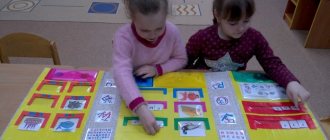Forms of communication with peers
Separation from an adult creates a new social development situation in which the child strives for independence and wants to actively act in the world of adults. The world of the people around you falls into two circles: close people and all other people. The child’s successes and failures, joys and sorrows depend on these relationships. Therefore, the social situation of development of this period is called “ child - social adult”
" Through relationships with adults, the child develops the ability to identify with people. The child learns accepted positive forms of communication that are appropriate in relationships with other people.
Communication with peers.
Adults remain a source of new information and assessment until the end of preschool age. However, during preschool age, other children take up more and more space in a child’s life. At 4-5 years old, a child already knows for sure that he needs other children and clearly prefers the company of his peers.
Features of communication with peers:
1. Variety of communicative actions.
When communicating with peers, a child is capable of not only arguing and demanding, but also deceiving and regretting. For the first time, coquetry, pretense, fantasy appear.
In relation to a peer, from 3 to 4 years old, the child solves the following tasks: managing the actions of a partner, control, evaluating actions, comparing with oneself.
2. Vivid emotional intensity.
Emotionality and relaxedness distinguishes communication with peers from communication with adults. Actions addressed to a peer are more affective. A preschooler is 3 times more likely to approve of a peer and 9 times more likely to conflict with him than with an adult.
From the age of 4, a peer becomes more attractive and a preferred partner.
3. Non-standard and unregulated communication.
If children adhere to certain rules of behavior when communicating with adults, then when communicating with peers they use the most unexpected actions:
they mimic, make faces, and compose fables
.
This freedom of communication allows the child to show his originality and individuality.
4. The predominance of proactive actions over reactive ones.
It is still difficult for a child to maintain and develop dialogue. For him, his own statements are more important than the speech of others. He supports an adult’s initiative 2 times more often than the proposals of another child.
In communication with peers, two turning points are observed at 4 years and 6 years:
At 4 years old, children clearly prefer the company of peers to adults and solitary play.
.
At the age of 6, selective affection begins to clearly manifest itself, friendship arises
.
Forms of communication with peers
1. Emotionally is a practical form of communication. (2-4 years)
The child expects his peers to participate in fun activities and craves self-expression. It is enough for him if a peer joins his game and intensifies the fun
At the same time, everyone strives to attract attention to themselves
2. Situational business form of communication (4-6 years)
This period was the heyday of the role-playing game. The plot-based role-playing game becomes collective. Outside the game: the guys agree on the distribution of roles, the conditions of the game)
3. Non-situational - business form of communication (6-7 years)
Half of the speech addresses to peers acquire an extra-situational character: that is, they talk about where they were, what they did, and evaluate the actions of a friend. “Pure communication” becomes possible, not bound by action or play. More and more contacts between children are observed at the level of real relationships, and less and less at the play level.
Along with the need for cooperation, the need for recognition and respect by peers is clearly highlighted.
Effective communication and interaction with preschoolers
Elvira Alexandrovna Petrova
Effective communication and interaction with preschoolers
An important task for adults is to create confidence in children that they are respected and cared for. This is a condition for the correct formation of a person’s mental world, education of the foundations of moral behavior. To develop such confidence in communicating with children, adults must follow the rule of unconditional acceptance (the “three P”
).
Understanding means the ability to see a child “from the inside
,” the ability to look at the world simultaneously from two points of view: one’s own and the child’s. For example, a refusal to answer may be perceived by a teacher as a manifestation of stubbornness, a desire to annoy the teacher. Viewing this situation in accordance with the principle of understanding allows for consideration of many more alternatives to explain the student's behavior. The teacher understands that the child’s behavior may be based on fear, lack of self-confidence, or a desire to report the presence of some problems. Depending on the interpretation that the child receives, the teacher’s actions will be different.
Acceptance is a positive attitude towards a child, his individuality, regardless of whether he pleases adults at the moment or not. This means: “I treat you well, regardless of whether you coped with this task or not!” Acceptance means that the child is accepted for who he really is, perhaps not too smart, causing a lot of trouble and trouble. Acceptance means recognition of the child’s right to his inherent individuality, to be different from others, including being different from his parents. This principle ensures that children feel accepted and loved regardless of the situation of success or failure in which they may find themselves.
Recognition is giving the child the right to resolve certain problems, the right to a deliberative voice. This principle does not mean the sameness of an adult and a child, but the equivalence of their needs, desires, and positions of interaction . Instead of saying things like “Here, take this...”
or
“Eat this...”
it is best to provide the child with an alternative, to offer a choice:
“What should I give you - this or that?”
.
Adults can express a positive attitude towards a child, show him that he is heard and understood, using in communication the rules of effective listening formulated by Yu. B. Gippenreiter. Let's take a closer look at some of them. Set aside special time to communicate Listen to him carefully, without being distracted by extraneous matters, react to this or that information that the child conveys (gestures, facial expressions, questions)
. Put aside your affairs, disconnect from everything extraneous and pay attention to the child.
Be patient when children are unable to say something right away. Since their heads are filled with new thoughts and words, they always need more time to put them into phrases. And when children are overwhelmed with emotions, the process becomes even more difficult. Be aware of the impact your words can have on your child. Children react very sensitively to comments, including non-verbal expressions of emotions. Tone of voice, facial expression, frowns or smiles all influence how a child perceives an adult's reaction. Ask questions to show your interest and participation. Keep them simple and short. Asking questions from adults also helps children develop their listening skills. Use the " I-message "
.
“When you... (the child’s actions, I feel... (my feelings because... (an explanation of why the child’s actions cause the described feelings)
. I would like to... (describe the desired course of events, designate my role and the child’s role). Applying the rules
of effective communication helps to establish open, trusting relationships with children and allows them to feel understanding and acceptance from adults.
When communicating with children, it is also important to avoid typical mistakes, which include, in particular, the following: Orders, commands: “Stop right now !”
;
“Take it away!”
;
“Don’t let me hear this again!”
;
“Shut up!”
inform the child that adults do not want to delve into his problems and do not respect his independence.
Such words evoke a feeling of powerlessness, or even “abandonment in trouble
.
In response, children usually resist, grumble
, take offense, and become stubborn.
Warnings, warnings, threats: “If you don’t stop crying, I’ll leave”
;
“See that it doesn’t get worse”
;
“This will happen again, and I’ll grab the belt!”
.
Most often, threats are meaningless because they do not contain information about how the situation can be corrected. And with frequent repetition, children get used to them and stop responding to them. Morals, moral teachings, sermons: “You must behave properly”
;
"You must respect adults
.
Usually children do not learn anything new from such phrases. They only feel the pressure of external authority, sometimes guilt, sometimes boredom, and most often all combined. Advice, ready-made solutions: “Take it and say it.”
.
“I think we need to go and apologize.”
;
“If I were you, I would fight back
.
Children are not inclined to listen to such advice, and sometimes they openly rebel. Behind the child’s negative reactions is the desire to be independent and make decisions on his own. After all, every time, advising something to a child, parents seem to tell him that he is still small and inexperienced, and they are smarter than him, they know everything in advance. Evidence, logical arguments, notations, “lectures”
:
“It’s time to know that you should wash your hands before eating”
;
“You get distracted endlessly, and that’s why you make mistakes”
;
“How many times have I told you!
If you didn’t listen, you have yourself to blame!” .
And here children, at best, stop hearing adults; a situation arises that psychologists call a “semantic barrier”
or
“psychological deafness
.
Criticism, reprimands, accusations: “What is it like!”
;
"It's all because of you"
;
.
” Such phrases do not play any educational role. They evoke in children either active defense: retaliatory attack, denial, anger; or despondency, depression, disappointment in yourself and in your relationship with your parents. In this case, the child develops low self-esteem; he begins to think that he really is bad, weak-willed, hopeless, that he is a loser. Praise: “Well done, you’re just a genius!”
; “You are our most beautiful (smart, capable!” After all that has been said, the recommendation not to praise a child sounds unexpected and strange. To understand the seeming contradiction, we must take into account that praise always has an element of evaluation. What is bad about praise and evaluation? Firstly ", the child soon begins to understand: where there is praise, there is a reprimand. Praising in some cases, he will be condemned in others.
Secondly, a child can become dependent on praise: wait for it, look for it ( “Why didn’t you praise me today?”
).
Or he may suspect that you are insincere, that is, you are praising him for some of your own reasons. It is much better to sincerely express your own feelings, for example: “I am so happy for you
.
Name-calling, ridicule: “Crybaby-vaxx”
;
“Don’t be a noodle”
,
“What a lazy person you are!”
.
All this is the best way to push a child away and “help”
him lose faith in himself.
As a rule, in such cases, children get offended and defend themselves: “Let it be noodles”
;
“Well, I’ll be like that!”
.
Guesses, interpretations: “I know it’s all because of you.”
;
“I suppose he got into a fight again!”
.
This can only be followed by a defensive reaction, a desire to avoid contact. Questioning, investigation: “No, tell me anyway”
;
“What happened anyway?”
;
"I'll find out anyway"
;
"Why are you silent?"
. It is difficult to resist asking questions in a conversation. Still, it is better to try to replace interrogative sentences with affirmative ones. For example, instead of
"Why are you angry?"
It’s better to say:
“I feel like you’re angry.”
For a worried child, this difference is great: a question sounds like cold curiosity, and an affirmative phrase sounds like understanding, sympathy, and participation.
Verbal sympathy, persuasion, exhortation. Of course, a child needs sympathy. But sometimes the words “I understand you”
,
“I sympathize with you”
may sound too formal.
Maybe instead just remain silent, holding him close to you. And in phrases like: “Calm down, don’t pay attention!”
;
“It’s okay”
- he may hear disdain for his concerns, denial or downplaying of his experiences.
Thus, one of the main conditions for creating an atmosphere of trust in relationships with children is their unconditional acceptance by adults, as well as their ability to use communication , thanks to which children could feel that they are not only understood, but also respected.
One of the most important problems of preschool education is communication , in which the child and the teacher participate. Psychologists confirm that the desire to communicate with adults is inherent in all children. And during the kindergarten day, they certainly share their thoughts, views, feelings with teachers, prove their independence, seek confirmation of the correctness of their moral position... While the preschooler is in a preschool institution , it is important for him to still feel that he is loved, and the teacher is responsible for this .
His main responsibility is to be able to establish relationships with children, no matter what methods are chosen: persuasion, example by action, confidential conversation...
At the same time, a teacher spends almost his entire life learning how to communicate with students .
What contributes to the efficiency of the process ?
A visible manifestation of goodwill - the teacher should be welcoming to all children to the same extent. He is able to lift the spirits of every pupil and help them overcome difficulties. The child’s very arrival at kindergarten is accompanied by a caring: “How are you doing?” Today we will..."
Stubbornness and disobedience of a generally conflict-free child may indicate ill will in
communication in a group .
Respect – the child is still small, but he is already a person. A good teacher will find an opportunity to emphasize his respect for each of the children and help in their self-affirmation.
The impact not only on the intellectual, but also on the emotional sphere of the pupils - both the child’s behavior and his attitude towards others changes for the better if he is helped not only to comprehend, but also to experience on an emotional level his own actions and actions. The teacher uses the emotional principle when he creates a friendly atmosphere in the group, uses vivid examples from life, and uses situations in the group to encourage children to empathize and sympathize. The same purpose is served by organizing public holidays and holding birthdays in the garden.
Attention to the individual characteristics of children - the teacher must remember that, for example, girls are more sociable than boys, their play activity is expressed somewhat differently. Children may have different abilities to communicate due to different psychological atmospheres in families.
Consistency of principles between educators and parents - it has long been confirmed that children develop morally more successfully if the educator, or preschool psychologist , coordinates his position with the position of parents or other adults taking part in raising the child and communicating with him . Discrepancy or opposition between requirements for children and fundamental views can foster such qualities as indiscipline, hypocrisy, and duplicity.
Work on strengthening your own authority - the teacher must remain an immutable authority, just like the parent. And this authority is based on the child’s sincere faith in the justice of the teacher’s actions, on the desire to imitate his actions. Hence the adult’s exactingness towards his every step, which young pupils can see and evaluate.
Forms of communication between preschoolers and peers
In the period from 3 to 7 years, forms of communication with peers are observed, which are consistently updated from younger to older preschool age:
- Emotional-practical
- Situational business
- Non-situational business
Communication among younger preschoolers is prompted by emotions or practical action. Kids can simply run up to each other with a joyful smile, and this is already a sign that they are interested in communicating
It is not so important how long their communication will captivate them. The emotionality of contact is valuable
The children's joint actions are still short-lived. They can make Easter cakes nearby or roll cars. They can demonstrate how far they throw a ball or slide down a slide. However, the emotional-practical form of communication provides the basis for the formation of initiative in communication.
In middle preschool age, children's business communication actively develops. This is due to the progress of the role-playing game. Preschoolers no longer play just side by side, but together, choosing more complex plots, distributing roles, and agreeing on the rules.
Some business qualities are demonstrated, but they are tied to situations. For example, a child may act as a strict controller in the game in accordance with the chosen role, but behave timidly in ordinary contacts.
Extra-situational relationships allow you to shift attention from the actions of the communication partner to the person himself. Unexpectedly, the preschooler begins to see his play partner as an interlocutor, a person with his own interests and preferences.
Another thing is that the revealed personality traits can either please or repel. Both a boy and a girl can tell their yesterday’s friend that they no longer play with him, because he takes other people’s toys without permission, offends others, etc.
The behavior of peers serves as a kind of mirror, allowing the child to see himself from the outside. And developing social intelligence helps the preschooler to notice the nuances of facial expressions and statements that previously escaped attention.
The role of adults in shaping children’s communication with peers
The development of all forms of communication between children and peers is possible only under the direct guidance of an adult. The child must sequentially go through all its forms.
But it happens that a 4-year-old child does not know how to play with peers, and at 5 years old is not able to maintain a basic conversation.
Is it possible to catch up and teach a child to communicate with adults and peers?
There are special classes for this and they are proactive in nature. What does it mean? An adult provides a child with patterns of communication that the child is not yet familiar with. To do this, you need to learn to communicate well enough yourself. The main problem when organizing such classes is not just to demonstrate to the child a perfect, yet inaccessible form of communication - cognitive or personal, but the ability to lead the child, imperceptibly including him in the communication itself.
Story games - let them communicate
Based on the achieved level of communication, you can invite the child to play a game together, the number of participants should not exceed 5-7 children.
The peculiarity of the game is that an adult is assigned the role of both a leader and a participant: he must follow the rules of the game, evaluate the actions of preschoolers, and at the same time be, on an equal basis with other children, the same participant in the game. In the process of joint actions, children have the opportunity to focus on the player - the partner, and not be offended if they lose. Together with other children, they experience joy and feel their importance in playing together. When conducting such activities, shy or withdrawn children begin to feel at ease, free and easy. After playing together with adults, such children cease to feel fear in communication and freely turn to an adult with a request or question. Thus, the development of non-situational communication with peers and adults moves forward at a slow pace.
Children become more relaxed when playing together
How does a child’s communication change throughout preschool age?
The need for communication is inherent in human nature. But this need has many nuances. At different age stages, communication performs its actual functions. The nature and motives of communication change even at such a short stage as preschool childhood.
Firstly, the circle of people with whom the child interacts is gradually expanding. First of all, these are adults who explain, help, and protect everything. But then the preschooler’s interest in communicating with children like himself becomes more active.
Secondly, the subject matter of communication changes. Communication based on practical actions is being replaced by mental communication. If a 3-4 year old child reaches out to his interlocutor to show what a beautiful dress a doll has or talk about a new car, then a five year old child can spend hours asking his “Why?”, simply walking next to his mother.
No improvised objects or toys are needed to ask where the sun sets, what the rainbow is made of, or why the chicken doesn’t fly. And all this interests children so much.
The progress of communication in preschool age continues further, introducing new motives for the need to communicate with adults or peers. Having bombarded their parents with questions about natural phenomena and learned something for themselves, children strive to share their knowledge with their peers. And adults are addressed with the next batch of questions - now about people’s relationships, professions, hobbies and other human subtleties.
Communication is the best opportunity to get to know the surrounding reality and yourself. This is one type of activity, which is why it is called a communicative activity. Preschoolers are involved in this activity. They are guided by different motives. Forms of communication in preschool age acquire an extra-situational character, since the development of cognitive processes and speech allows the child to reason abstractly, and not just about what he sees and hears at a particular moment.
Basic conditions for the development of communication in preschool age
Close people play a primary role in a child’s life, and the child’s involvement in communication depends on them. Unlike older children, any activity of preschoolers is directed by adults. The corresponding features of communication between preschool children are emerging:
- An adult gradually immerses the child in the knowledge and skills developed by many generations of humanity, and without which life is unthinkable.
- The child perceives adults as a model - how to behave, what feelings and qualities to show in various situations.
- When communicating with adults, the preschooler receives feedback in the form of support and praise.
- Communication with peers provides an opportunity for a child to get to know himself and realize that he is one of the same children.
Motives for communication among preschoolers
Let's find out what motives drive preschoolers when they initiate communication with an adult or peer. A 3-year-old child hands his dad parts of a construction set - this is already an invitation to interact. The 4-year-old “why” besieges his parents with questions about what and how. A 5-year-old preschooler sits his grandmother in a chair and declares that he will treat her. A 6-7 year old child declares that he will go play with Mishka, but he is not interested in playing with Vladik.
In any of these cases, a leading motive appears. , cognitive motives predominate . Children understand that adults can and know a lot, therefore, in addition to emotional attraction to adults, they are driven by cognitive interest.
In middle preschool age, children need play partners. They are attracted to story-based games that simulate everyday life.
And since the most efficient play partner is an adult, children love to involve the role of mothers, grandmothers and, less often, the male part of the family in playing the role. Let gaming activities take place, but business motives of communication predominate at this age.
Older preschoolers actively communicate with both adults and peers. They become selective in relation to their peers. They make friends with whom they are ready to play “mother-daughter”, football and any other game. But a category of children with whom they do not intend to communicate is also identified. And if you play in a team game, then on different teams. Personal motives come to the fore at this age stage .
6-year-old children also continue to approach adults with questions or a desire to hear evaluation and praise. Along with knowledge of the world, they are now often interested in issues of a moral nature. The motives for communication between preschool children and adults in such cases can also be attributed to personal ones.
Development of communication skills in preschool children
The communication need is special. It develops as a need to know oneself and other people. To satisfy this need, at least primary communication skills are important. What communication skills can we talk about at the age of 3-5 years?..
To guide your child in developing successful interactions, pay attention to how your child expresses himself when trying to communicate with similar kids. Communication among younger preschoolers is characterized by:
- Attention to a peer as someone “like myself.”
- Emotional perception of interaction with a peer.
- The desire to show oneself to one’s peers: what I can do, how I do it.
- Sensitivity and receptivity to how your little communication partner treats you.
All of the above components are important. When observing a child, it is easy for adults to notice what is present in abundance and what manifestations are completely absent. For example, if a preschooler is just demonstrating his achievements, you need to intervene and suggest: “Let’s see how a girl/boy can do...”, “You showed off your excavator, and now your friend wants to demonstrate how his cars drive.”
It is useful to regulate the emotional background of communication between preschoolers. For children who are frowning, their mood will be disturbed. Changes in emotions are facilitated by surprise. Figure out how to surprise the kids (by building an unusual tower, demonstrating the unobvious advantages of a familiar toy, etc.), and you will see how their mood will change positively and communication will begin.
If you instill a culture of interaction from early childhood, over time, younger preschoolers intuitively demonstrate such an important quality - paying attention to their communication partner. This is an opportunity to develop the child's communication skills.
Communication among older preschoolers is more multifaceted. After 5 years, children spend significant time with peers. They are connected by various activities that require communication.
This is a role-playing game, creativity, and productive activity. Interaction with others often takes the form of cooperation.
How successful the cooperation will be depends on each participant. In older preschool age, the development of communication skills is closely intertwined with the formation of moral qualities. Goodwill and attention to others, affability and friendliness, willingness to help each other and the ability to give in are qualities without which interpersonal relationships cannot be successful.
Communication as a necessary condition for the development of a preschooler’s personality
For a preschooler, a peer society is a mirror in which he sees his reflection. In different years, a child can see only some of the qualities of his partners: “she’s kind,” “he’s greedy,” “that boy fights,” “that girl is sad again”... However, thanks to such reflections, the preschooler understands himself more. He determines what virtues and qualities he has by comparing himself with his peers.
Among their peers, children repeat moral judgments that they themselves have repeatedly heard from adults. Nothing helps awareness more than speaking out loud. By teaching their peers, children comprehend the true meaning of morality: what is possible, what is not, how to support a friend, and what will bring offense.
Of course, in children's communication there is a lot of categoricalness and little consideration. However, by the end of preschool age, children discover the value of personal qualities, which is the main achievement of communication between older preschoolers and peers.
How do preschoolers communicate with others?
If we briefly consider how forms of communication progress in preschool age, then it is best to turn to the work of the famous psychologist M.I. Lisina, who identified four levels of communication from infancy to 7 years, designating them as a form:
- Situational-personal
- Situational business
- Extra-situational-cognitive
- Extra-situational-personal
The first ones in this list are formed earlier, based on specific actions, objects, and experiences. By older preschool age, they do not disappear, but partially give way to more developed forms that are not tied to the situation. These changes are facilitated by the development of children's speech and verbal-logical thinking.
The highest form of communication for preschool age is one that promotes understanding of the meaning of human relationships, as well as the assimilation of the norms and values of society. Consequently, this is an extra-situational-personal form of communication.
Some features of personal communication
The desire to communicate with adults largely depends on the personal expectations of the preschooler. If a child has a predominantly positive experience of previous contacts with specific adults, he is drawn to them. Conversely, negative impressions cancel out the desire to communicate. Some grandmothers wonder why their grandchildren are so reluctant to visit them. They don’t even notice how zealously they protect the inviolability of their shelves, how strictly they reprimand the child when he violates the usual order in their apartment.
Personally, a preschooler needs warm emotional connections and adults to be interested in him, his activities and skills. The child expects support and empathy, he is sensitive to praise. This does not mean that children should be praised. But there will always be achievements worth celebrating.
It is curious, but the following phenomenon is observed: loving parents and grandparents always find a reason to support and praise the child. If there are no warm feelings, the child is often scolded and his mistakes pointed out rather than supported.
Children are attracted to the positive emotional content of relationships with significant adults. This is the favorable background against which cognitive and personal communication is successfully implemented.





